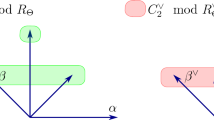Abstract
We study the high-dimensional limit of (projective) Stiefel and flag manifolds as metric measure spaces in Gromov’s topology. The limits are either the infinite-dimensional Gaussian space or its quotient by some mm-isomorphic group actions, which are drastically different from the manifolds. As a corollary, we obtain some asymptotic estimates of the observable diameter of (projective) Stiefel and flag manifolds.
Similar content being viewed by others
References
Billingsley, P.: Convergence of probability measures, 2nd ed., Wiley Series in Probability and Statistics: Probability and Statistics, John Wiley & Sons Inc., New York, 1999. A Wiley-Interscience Publication
Bogachev, V.I.: Measure theory, vol. I, II. Springer, Berlin (2007)
Burago, D., Burago, Y., Ivanov, S.: A course in metric geometry, Graduate Studies in Mathematics, vol. 33. American Mathematical Society, Providence, RI (2001)
Cai, T., Fan, J., Jiang, T.: Distributions of angles in random packing on spheres. J. Mach. Learn. Res. 14, 1837–1864 (2013)
Gromov, M.: Metric structures for Riemannian and non-Riemannian spaces, Reprint of the 2001 English edition, Modern Birkhäuser Classics, Birkhäuser Boston Inc., Boston, MA, 2007. Based on the 1981 French original; with appendices by M. Katz, P. Pansu and S. Semmes; Translated from the French by Sean Michael Bates
Gromov, M., Milman, V.D.: A topological application of the isoperimetric inequality. Am. J. Math. 105(4), 843–854 (1983)
Kechris, A.S.: Classical descriptive set theory, graduate texts in mathematics, vol. 156. Springer, New York (1995)
Ledoux, M.: The concentration of measure phenomenon, Mathematical Surveys and Monographs, vol. 89. American Mathematical Society, Providence, RI (2001)
Lévy, P.: Problèmes concrets d’analyse fonctionnelle. Avec un complément sur les fonctionnelles analytiques par F. Pellegrino, 2nd edn. Gauthier-Villars, Paris (1951). (French)
Li, R.C.: A perturbation bound for the generalized polar decomposition. BIT 33(2), 304–308 (1993)
Milman, V.D.: Asymptotic properties of functions of several variables that are defined on homogeneous spaces, Dokl. Akad. Nauk SSSR 199, 1247–1250 (1971) (Russian); English transl., Soviet Math. Dokl. 12, 1277–1281 (1971)
Milman, V.D.: A certain property of functions defined on infinite-dimensional manifolds. Dokl. Akad. Nauk SSSR 200, 781–784 (1971). (Russian)
Milman, V.D.: The heritage of P. Lévy in geometrical functional analysis, Astérisque 157-158, 273–301 (1988). Colloque Paul Lévy sur les Processus Stochastiques (Palaiseau, 1987)
Milman, V.D., Schechtman, G.: Asymptotic theory of finite-dimensional normed spaces, Lecture Notes in Mathematics, vol. 1200, Springer-Verlag, Berlin, 1986. With an appendix by M. Gromov
Ozawa, R., Shioya, T.: Limit formulas for metric measure invariants and phase transition property. Math. Z. 280(3–4), 759–782 (2015)
Shioya, T.: Metric measure geometry–Gromov’s theory of convergence and concentration of metrics and measures, IRMA Lectures in Mathematics and Theoretical Physics, vol. 25, European Mathematical Society (2016)
Shioya, T.: Metric measure limits of spheres and complex projective spaces, Measure Theory in Non-Smooth Spaces (N. Gigli, ed.), Partial Differential Equations and Measure Theory, De Gruyter, pp. 261–287 (2017)
Watson, G.S.: Limit theorems on high-dimensional spheres and Stiefel manifolds, studies in econometrics, time series, and multivariate statistics, pp. 559–570. Academic Press, New York (1983)
Zhang, F.: Quaternions and matrices of quaternions. Linear Algebra Appl. 251, 21–57 (1997)
Author information
Authors and Affiliations
Corresponding author
Additional information
This work was supported by JSPS KAKENHI Grant Numbers 26400060, 15K17536, 15H05739.
A. Appendix: \(U^F(N)\) as a subgroup of \(U^\mathbb {R}(N^F)\)
A. Appendix: \(U^F(N)\) as a subgroup of \(U^\mathbb {R}(N^F)\)
For \(z:=z_0+z_1{\mathrm{i}}+z_2{\mathrm{j}}+z_3{\mathrm{k}}\in F^N\), we set
It follows that for \(z:=z_0+z_1{\mathrm{i}}+z_2{\mathrm{j}}+z_3{\mathrm{k}}, w:=w_0+w_1{\mathrm{i}}+w_2{\mathrm{j}}+w_3{\mathrm{k}}\in F^N\),
Lemma A.1
Define a map \({\mathcal {O}}^F: U^F(N) \hookrightarrow \mathrm {M}_{N^F}(\mathbb {R})\) by
for \(z_0,z_1,z_2,z_3 \in \mathbb {R}^N\), where \(z:=z_0+z_1{\mathrm{i}}+z_2{\mathrm{j}}+z_3{\mathrm{k}}\in F^N\). Then we have for \(U, V \in U^F(N)\),
Proof
For any \(z:=z_0+z_1{\mathrm{i}}+z_2{\mathrm{j}}+z_3{\mathrm{k}}, w:=w_0+w_1{\mathrm{i}}+w_2{\mathrm{j}}+w_3{\mathrm{k}}\in F^N\) and \(U,V \in U^F(N)\), we compute that
implying the first two claims. We also find that \({\mathcal {O}}^{F}(I_N)=I_{N^F}\). This implies that
hence \({\mathcal {O}}^{F}(U^*)={\mathcal {O}}^{F}(U)^*\). This completes the proof. \(\square \)
Rights and permissions
About this article
Cite this article
Shioya, T., Takatsu, A. High-dimensional metric-measure limit of Stiefel and flag manifolds. Math. Z. 290, 873–907 (2018). https://doi.org/10.1007/s00209-018-2044-y
Received:
Accepted:
Published:
Issue Date:
DOI: https://doi.org/10.1007/s00209-018-2044-y



